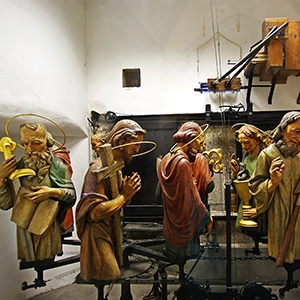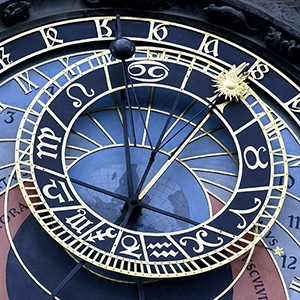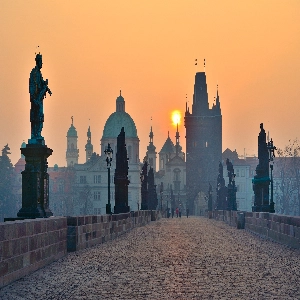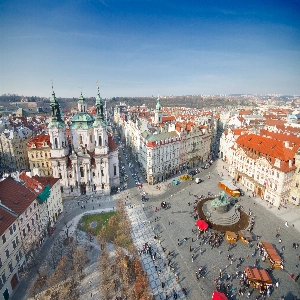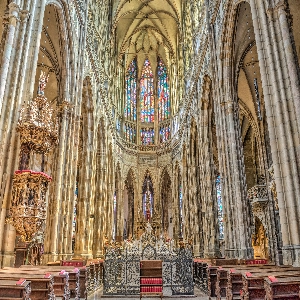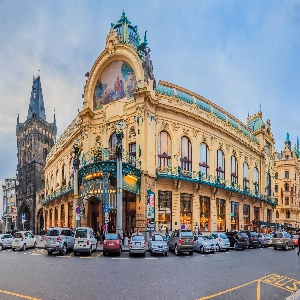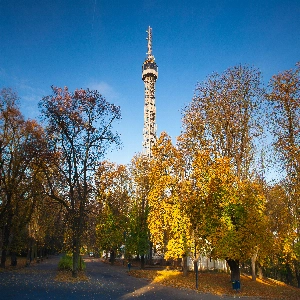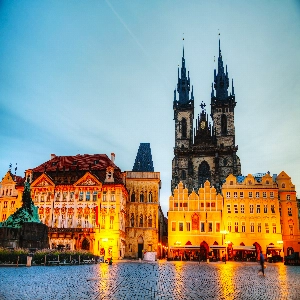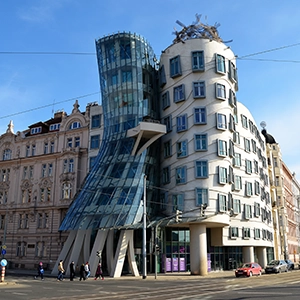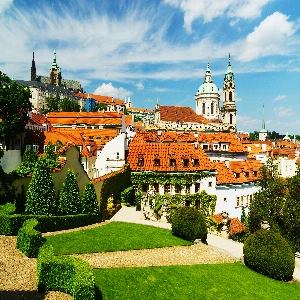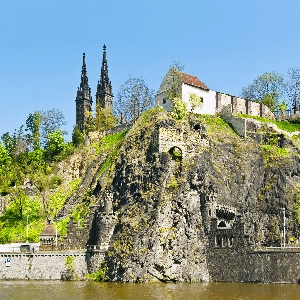The Mystery & Wonder Of The Prague Astronomical Clock
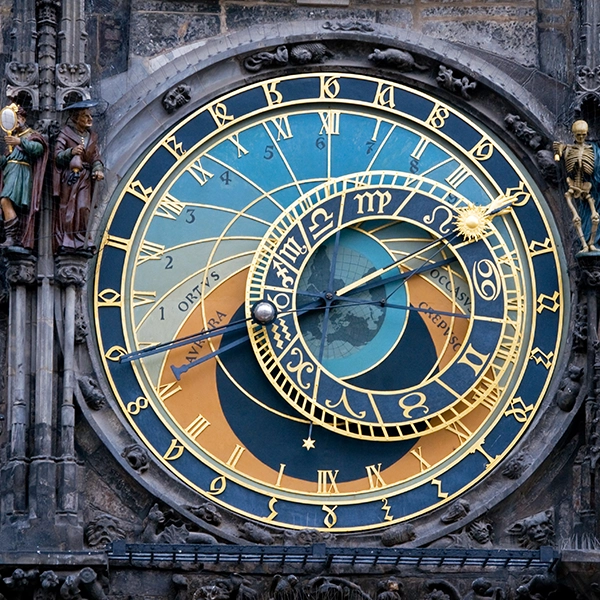
The Prague Astronomical Clock is like an ancient treasure that has been keeping time for centuries. It's amazing to think that the clock has been ticking away for over 600 years, through wars, revolutions, and countless changes in the world.
The clock's age and precision are a tribute to the ingenuity and creativity of the clockmakers who built it. They must have been true masters of their craft to create something so intricate and reliable.
The clock is also a work of art, with its beautiful design and decoration. The figures that move across the dial add a touch of whimsy and magic, and they are beloved by both visitors and locals alike.
Overall, the Prague Astronomical Clock is a living piece of history, a window into the past that connects us to the people and traditions that came before us. It's no wonder that it's become such an iconic symbol of Prague, and a must-see attraction for anyone visiting the city.
The Curse Of The Prague Astronomical Clock
The Curse of the Prague Astronomical Clock: The Enigmatic Tale of the Ancient Timepiece A dark and enchanting tale swaddles the world-famous Prague Astronomical Clock, a masterpiece of medieval engineering. This 15th-century wonder is not only an artistic and scientific marvel but also is shrouded in an eerie legend passed down through generations. Nestled in the heart of Prague’s Old Town Square, the clock’s hauntingly beautiful blue dial has been an iconic symbol of the city since 1410. However, the horologe harbors an alluring secret. Legend has it that a curse befell the clockmaker who crafted the intricate timepiece. Bewitched by jealousy, the town councillors ordered the master horologist to be blinded, ensuring he could never recreate an equally captivating clock. It’s said that the vengeful clockmaker cursed the timepiece so that any future attempts to repair or alter its mechanics would end in disaster. Over the centuries, many attempts to restore the magnificent clock have been met with tragic outcomes, while catastrophe has befallen those who dared to tamper with its fabled mechanisms. Is the curse of the Prague Astronomical Clock simply a dark musing, or a chilling reality concealed within the gears of the ancient masterpiece? One question remains: Does the enigmatic curse still hold power, enveloping the clock’s mechanism like an intricate veil?
History Of The Prague Astronomical Clock
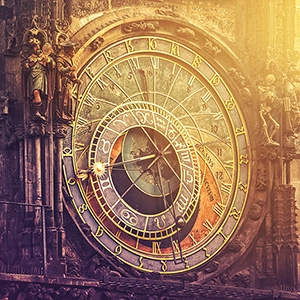
The Prague Astronomical Clock: A Timeless Legacy The history of the Prague Astronomical Clock, or "Pražský orloj," is a mesmerizing tale that interweaves science, art, and national pride. Installed on the southern wall of Old Town Hall in the heart of the Czech Republic's capital city, this stunning mechanical marvel dates back over six centuries and continues to draw travelers from around the world. Commissioned by the city council of Prague in 1410, this formidable timekeeping device was a collaboration between clockmaker Mikuláš of Kadaň and mathematician-astronomer Jan Šindel. What sets the Prague Astronomical Clock apart from its contemporaries is its ability to track not only time but also the complex movement of celestial bodies. The ornate clock face and intricate dials display the position of the sun, moon, and stars, as well as various Christian holidays and astronomical events such as lunar eclipses. Equally fascinating is the clock's hourly "Walk of the Apostles" show – a captivating parade of animated figures, including Death itself, which sends shivers of awe down the spines of spectators. Beyond its technical feats, the Prague Astronomical Clock is a testament to Czech craftsmanship and a powerful symbol of the nation's resilience. Having survived numerous wars, political upheavals, and even a damaged main gear that nearly caused the clock to be dismantled, the clock's ongoing tick is a timeless reminder of perseverance through adversity.
What Is The Best Time To Visit The Prague Clock
Discover The Magic: Unravel The Best Time to Visit The Prague Clock As you meander through the charming cobblestone streets of Prague, the quaint capital of the Czech Republic, the breathtaking sight of the Prague Clock, also known as Prague Astronomical Clock or Orloj, captures your imagination. Sitting at the heart of the Old Town Square, this centuries-old gem with a storied past is an enchanting confluence of medieval engineering, fascinating astronomical ingenuity, and Gothic brilliance. When it comes to the best time to visit the Prague Clock, it ultimately depends on what kind of experience you wish to have. If you prefer a peaceful encounter with a significantly quieter Old Town Square, then the early morning hours are perfect. Choosing to visit the Clock between 9:30 AM-10:00 AM or 3:00 PM-3:30 PM has a special perk: you will be treated to an entertaining show with the Clock's mechanical marvels performing on the hour for your delight. For those who thrive on the bustling and lively holiday vibe, visiting in the afternoon and evening hours during festival seasons is highly recommended. The entire square comes alive with street-side stalls, traditional dance, and music performances that accentuate the allure of the Orloj. Remember, no matter which hour you choose, it is always worth making the time to witness the awe-inspiring magnificence of the Prague Clock!
What Is The Prague Astronomical Clock Made Of
Discovering the Intricacies of the Prague Astronomical Clock: What is it Made Of? Nestled in the heart of Prague, in the charming Old Town Square, lies an enchanting medieval marvel – the Prague Astronomical Clock (also known as the Orloj). As the third-oldest astronomical clock in the world and the oldest one still in operation, this 600-year old masterpiece is not only a testament to the city's rich history but also a fascinating work of art and technology. A frequent question asked by the thousands of tourists who flock to see this enchanting timepiece is, "What is the Prague Astronomical Clock made of?" Primarily constructed from metal and stone, the Orloj is an exquisite creation that combines craftsmanship and engineering. The clock has three main components: the astronomical dial, the calendar dial, and the mechanical moving sculptures that perform an enchanting hourly show. The astronomical dial is made of a metal framework and enamel, with beautifully painted zodiac signs and intricate symbols. The calendar dial, noted for its stunningly engraved medallions that represent the twelve months, is made of stone - a testament to the stonemasonry skills of the artisans of its time. Behind its captivating exterior lies the complex mechanism made of iron gears and brass wheels, showcasing the extraordinary workmanship of medieval watchmakers. As an emblem of technical prowess and artistic talent, the Prague Astronomical Clock remains an endearing symbol of the city's historical and cultural legacy – a must-see for anyone exploring the enchanting streets of Prague.
Who Built The Prague Astronomical Clock
Unveiling the Creator of the Renowned Prague Astronomical Clock A timeless marvel, the Prague Astronomical Clock, or Orloj, is a bewildering medieval timepiece that has captured the imaginations of admirers for centuries. Situated at the heart of the bustling city, the clock's enigmatic mechanisms and ethereal aesthetics continue to draw visitors from around the world. As one gazes upon the intricate dials and statues decorating the clock's facade, many questions arise, including the most compelling of all: who built the Prague Astronomical Clock? Records tell us that the Orloj was first installed in 1410, making it the third oldest astronomical clock in existence and the oldest still in operation. The clock was the brainchild of clockmaker Mikuláš of Kadaň and astronomer Jan Šindel. However, the clock's dazzling appearance today is the culmination of various master artisans' efforts over time. During its six centuries in existence, the Orloj underwent several revisions and restorations. While the original creators were masters of their time, it was revered clockmakers like Hanuš and Jan Táborský who helped refine the timepiece into the enchanting wonder we witness today. Now, as you revel in the charm of the clock's spectacle, you can appreciate the combined genius of the remarkable individuals who constructed this piece of history. The Prague Astronomical Clock stands not only as a testimony to its creators' craftsmanship and intellect but also as a symbol of human fascination with space and our irrevocable connection to the celestial sphere.
Why Was The Prague Astronomical Clock Built
An Enigma of Time: Why Was The Prague Astronomical Clock Built? When one thinks of Prague, an iconic symbol comes to mind: the mysterious and enchanting Prague Astronomical Clock. Located in the heart of the Old Town Square, this majestic structure has stood for centuries, perplexing locals as well as Millions of tourists each year. From its unique façade to its intricate mechanisms, every aspect of the clock is an embodiment of masterful craftsmanship. But why was this captivating clock built in the first place? The story of the Prague Astronomical Clock dates back to the 15th century when the city of Prague was flourishing under the reign of Holy Roman Emperor Charles IV. It is believed that the clock's construction was commissioned to showcase the city's prosperity and knowledge. There are various theories suggesting that the clock's purpose extended beyond mere time-telling; offering significant insight into complex astronomical movements and the position of celestial bodies. Interestingly, some also believe that the clock contains hidden symbols and secret messages embedded by its creator, Mikuláš of Kadaň, and other master craftsmen during its construction. Regardless of the reasons, the Prague Astronomical Clock has withstood the test of time and remains an enduring masterpiece worthy of exploration. Whether you seek to decipher its celestial language, discover its myths and legends or simply immerse yourself in the enchanting atmosphere of Old Town Square, the question 'Why Was The Prague Astronomical Clock Built' is an invitation to step back in time and unravel the mysteries of a fascinating piece of history.
Where Is The Prague Astronomical Clock
Discover the Enigmatic Timepiece: Where is the Prague Astronomical Clock? Nestled in the heart of Europe, and equally rich in history and charm, lies Prague, the medieval capital of the Czech Republic. A cultural melting pot, this captivating city is home to an incredible timekeeping masterpiece—The Prague Astronomical Clock, known also as Orloj in the local language. The question beckons, where is the Prague Astronomical Clock? Situated in the Old Town Square, the Prague Astronomical Clock is an extraordinary testament to the ingenuity of medieval engineering, blending intricate craftsmanship and astrological symbolism. This enchanting clock doesn't just tell the time; it illustrates the positions of the Sun, Moon, and other celestial bodies and even showcases a parade of the Twelve Apostles every hour. Installed in 1410 on the southern wall of the Old Town Hall, it remains a fascinating attraction, drawing scores of visitors each year, eager to unravel the mysteries of this mesmerizing timepiece. With its remarkable visual appeal and historical relevance, the Prague Astronomical Clock is not just a must-see landmark but also a compelling experience in understanding the scientific and artistic pursuits of a bygone era. Next time you find yourself wandering through the enchanting cobblestone streets of Prague's Old Town, make sure to stop and let yourself be mesmerized by the timeless wonder of the Prague Astronomical Clock.
How To Read The Prague Astronomical Clock

Unlocking the Secrets: How To Read the Prague Astronomical Clock As you stroll through the historic streets of Prague, you may find yourself captivated by the enigmatic monument towering over Old Town Square - the Prague Astronomical Clock. As the third oldest astronomical clock in the world, it has drawn back the veil of mystery around the cosmos since 1410. But the baffling dials and intricate mechanisms can be daunting to the uninitiated observer. Fear not - this introductory guide will illuminate the secrets of reading the Prague Astronomical Clock. The clock's stunning facade invites passers-by to pause and wonder. The ornate dials track celestial movements and even offer a glimpse into medieval understandings of time. The outermost blue ring exhibits the signs of the zodiac, the next concentric dial clocks the Old Czech Time, while the golden sun-hand traces the sun's path across the sky on the ecliptic. Inside this complex timepiece, a captivating blend of science and art emerges: astronomical cycles, saints' days, and local legends are meticulously woven into the clock's fabric. As a mechanical marvel and a profound symbol of human curiosity, the Prague Astronomical Clock kindles the imagination and beckons the spirit of exploration. It is time for you to delve into the celestial world - learn how to read the Prague Astronomical Clock, and discover the stars and stories hidden within its enigmatic heart.
Facts About The Prague Astronomical Clock
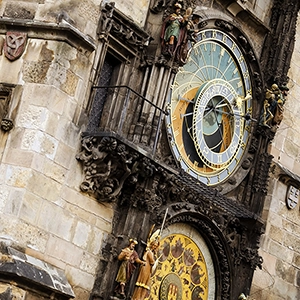
Facts About The Prague Astronomical Clock: A Timeless Wonder Nestled in the heart of Prague's Old Town Square, the Prague Astronomical Clock, or Prague Orloj, continues to enchant visitors and locals alike with its intricate design and celestial movements. As the third-oldest astronomical clock in the world and the oldest one still in operation, the Orloj boasts a rich history and fascinating facts that pique curiosity and inspire awe. Constructed in 1410 by clockmaker Mikuláš of Kadaň and mathematician-astronomer Jan Šindel, the Prague Astronomical Clock has not only witnessed centuries of human history but has also undergone numerous modifications and restorations. The intricate clock face displays not only the time but also the position of the sun and moon, as well as a calendar dial to mark important feast days and astronomical events. Adding to the clock's allure is the hourly spectacle called "The Walk of the Apostles," where wooden figures representing the twelve apostles parade past two windows above the clock face, while other allegorical statues, including Death and Vanity, set the stage for a captivating show. Intriguing, complex, and steeped in history, the Prague Astronomical Clock remains an enduring symbol of human ingenuity and a must-visit destination for those exploring the timeless beauty of Prague.




